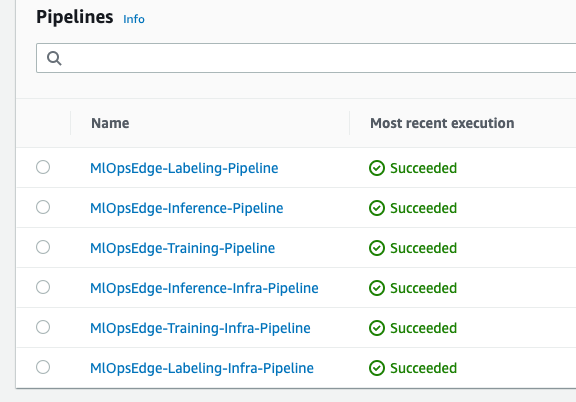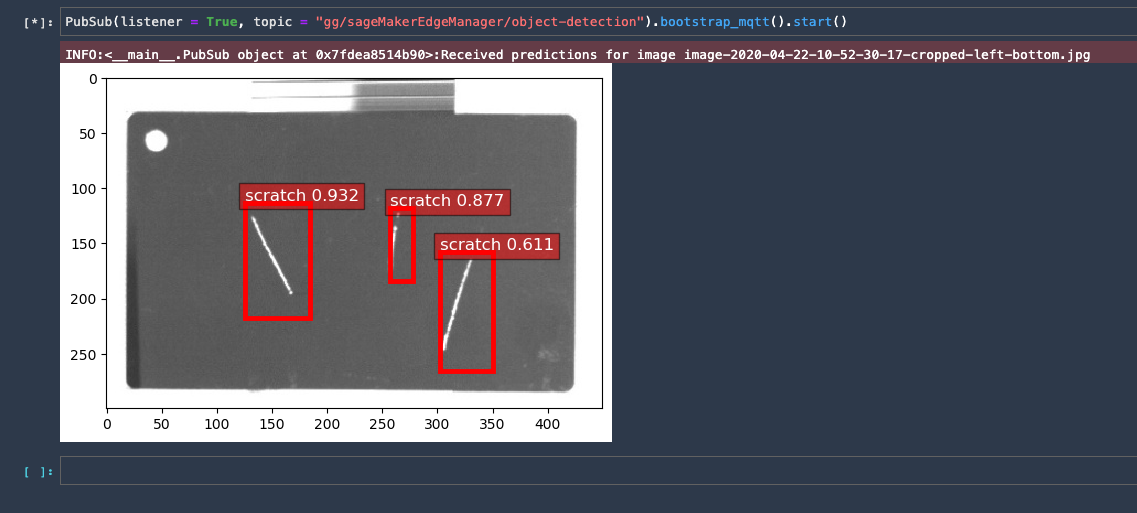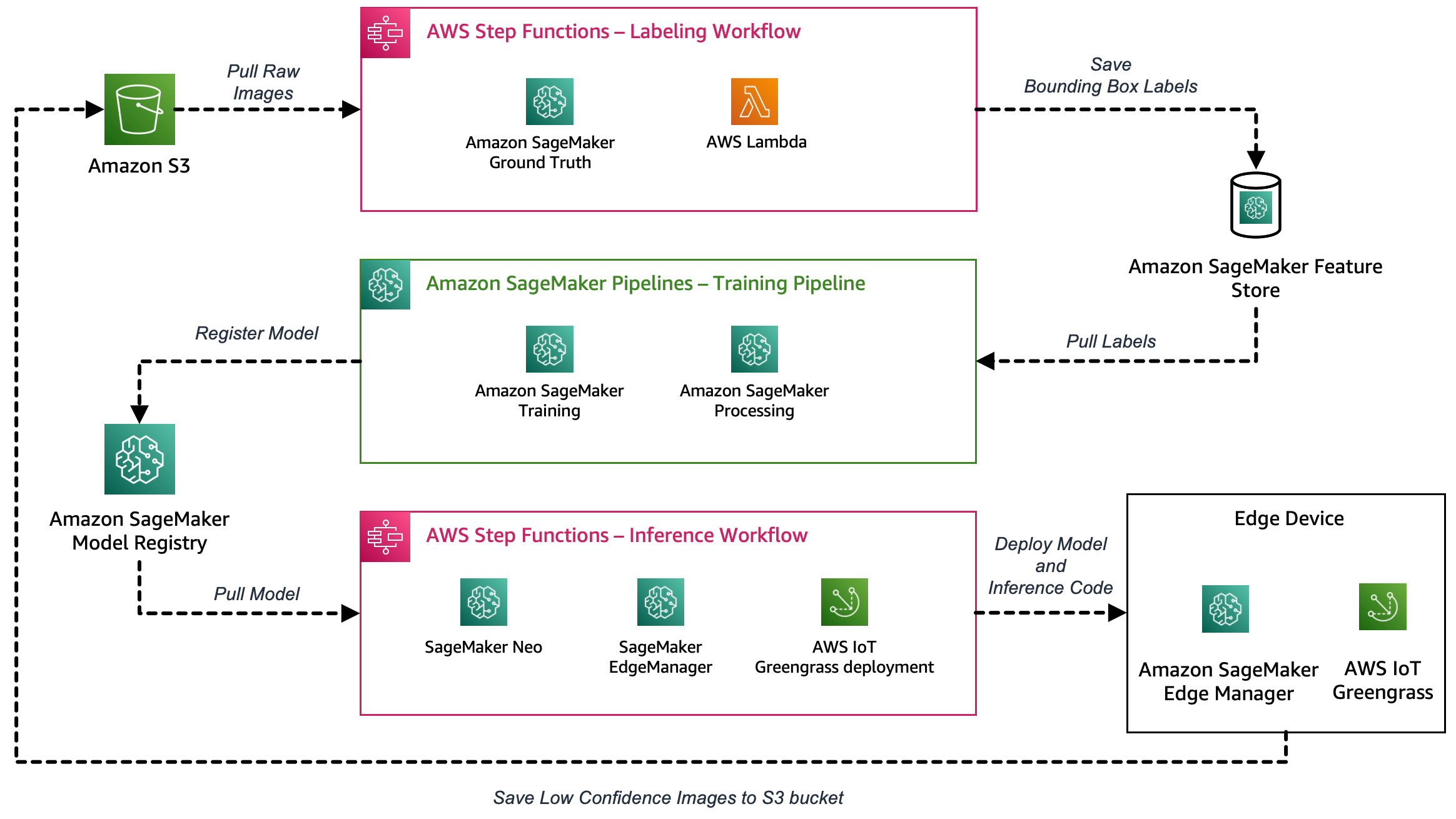End-to-End MLOps Example for visual quality inspection at the edge using Amazon SageMaker, AWS Greengrass, AWS CodePipeline and AWS CDK
This is a sample implementation for an end-to-end MLOps pipeline for quality inspection at the edge based on Amazon SageMaker and AWS Greengrass. The focus is to provide an end-to-end example including following components:
- Labeling - Automated labeling of the images using SageMaker Ground Truth
- Training - Training and evaluation of the bounding box detection model using Amazon SageMaker
- Inference - Compilation, Packaging and Deployment of the model to an edge device for inference running AWS Greengrass.
Deployment of each of these pipeline components is fully automated using AWS CodePipeline and AWS CDK. Each component is implemented as separate CDK app and pipeline in AWS CodePipeline. This allows deploying Labeling, Training and Inference separately in case you want to dive deeper into each of these aspects individually.
Before installing this sample, make sure you have following installed:
- Fork this repo in your GitHub account
- Create a GitHub connection using the CodePipeline console to provide CodePipeline with access to your GitHub repositories (See section Create a connection to GitHub (CLI))
- Update the GitHub related configuration in the
./repo_config.yamlfile- Set the value of repoType to
GITHUB - Update the value of githubConnectionArn, githubRepoOwner and repoName
- Set the value of repoType to
- Commit and push the changed file to your fork
Alternatively, the CDK Infrastructure code can provision a CodeCommit Repo as Source Repo for you.
To choose this option, set the value of repoType to CODECOMMIT in the ./repo_config.yaml file.
This repo uses the AWS Cloud Development Kit (AWS CDK) v2. AWS CDK requires you to bootstrap your AWS account before deploying with CDK (see Bootstrapping in the AWS CDK documentation).
Either follow the steps described in the manual our run make bootstrap-cdk to boostrap your AWS account.
After completing the Prerequisites just run
make deploy
to deploy the full solution!
Note: full deployment can take more than 20 minutes depending on your internet connection. CDK is using Docker and needs to download build images the first time you run it.
Once deployment is finished open the AWS CodePipeline console to validate your CodePipelines. Once all Codepipelines finished deploying, your console should look like this:
Note: On first deployment, full deployment of all pipelines takes about 1 hour.
The greengrass device runs inference on a set of sample images to simulate the camera and publishes results every 5 seconds to an MQTT topic. The quickest way to validate this is to use the MQTT client in the AWS console:
- Open the MQTT client
- In the topic filter type:
qualityinspection/scratch-detectionand hit theSubscribebutton - You should see an output like below after about 5 seconds:
{
"timestamp": "2022-09-02 07:20:14.861283+00:00",
"image_name": "image-2020-04-22-10-51-26-67-cropped-right-top.jpg",
"inference_results": [
[
[
0,
0,
0
],
[
0.8552689552307129,
0.7992166876792908,
0.6160680055618286
],
[
[
274.1676025390625,
117.75273895263672,
295.042236328125,
187.58438110351562
],
[
141.7375946044922,
117.36134338378906,
202.3010711669922,
215.0024871826172
],
[
327.2494812011719,
167.72132873535156,
359.4731140136719,
260.1994323730469
]
]
]
]
}
The inference results has 3 arrays:
- the class detected (in our case 0 equals scratch)
- the probability from 0 to 1
- bounding box coordinates (absolute coordinates)
You can also visualize the inferences done by the greengrass device using a jupyter notebook. For executing the notebook you need a notebook environment like SageMaker Studio. Follow these steps to test the inference using a notebook:
- Configure and Open SageMaker Studio
- Open a terminal
- Clone this repository and open the notebook notebooks/Test-Inference.ipynb
- At the top select
Run - Run all cells - Once execution finishes it should visualise incoming inferences at the bottom like this:
This is the architecture overview for the quality inspection MLOps pipeline showing the high level components and services used:
If you want to dive deeper into each component, check out the relevant Readme files:
- Labeling - Automated labeling of the images using SageMaker Ground Truth
- Training - Training and evaluation of the bounding box detection model using Amazon SageMaker
- Inference - Compilation, Packaging and Deployment of the model to an edge device for inference running AWS Greengrass.
- MLOps infrastructure - Provides the MLOps infrastructure needed like SageMaker Feature Store, SageMaker Model Registry and S3 Bucket
- doc - documentation artifacts
- inference - cdk app to deploy all artifacts related to edge deployment
- init - cdk app to deploy MLOps infrastucture like S3 bucket, SageMaker Model Registry Model Group or SageMaker Feature Store Feature Group
- labeling - cdk app to deploy all artifacts related to data labeling
- notebooks - utility notebooks to test inference or browse SageMaker feature store
- training - cdk app to deploy all artifacts related to model building and training
Important: this application uses various AWS services and there are costs associated with these services after the Free Tier usage - please see the AWS Pricing page for details. Depending on how often you run the pipeline costs may vary. However with standard usage (2 pipeline runs per day), cost will be below 5 dollars per day beyond free tier.
Run make destroy to cleanup all related resources in your account.
This library is licensed under the MIT-0 License. See the LICENSE file.
Refer to CONTRIBUTING for more details on how to contribute to this project.
See CONTRIBUTING for more information.


